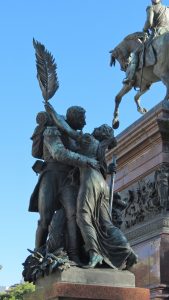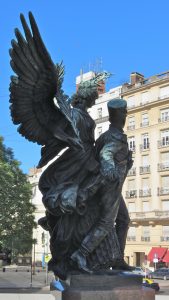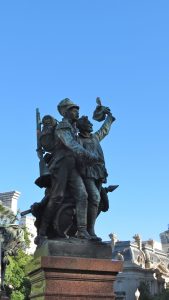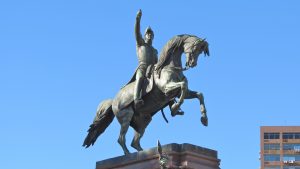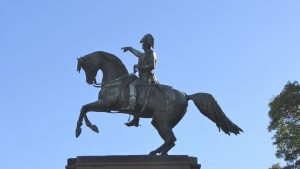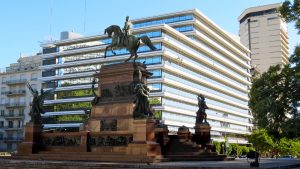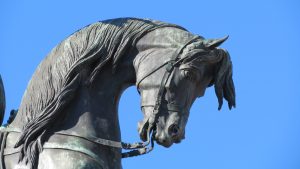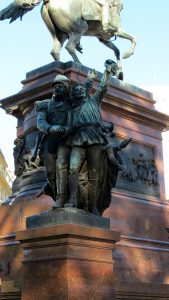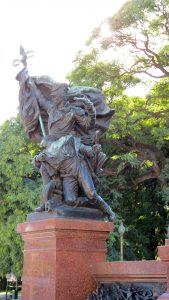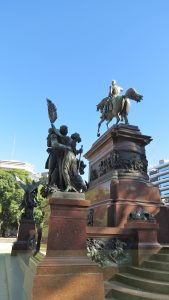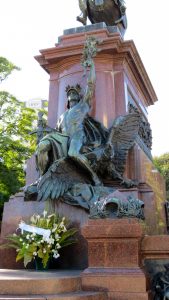- CountryArgentina
- Town:Buenos Aires
-
Year of creation:1862
- Rider(s):San Martin, José de
(1778–1850) was born in Argentine and went to Spain at an early age for his (military) education. He served for two decades in the Spanish army, rising to Lieutenant Colonel of Cavalry and fighting for three years against Napoleon’s troops. On his return to Buenos Aires in 1812, he switched to fighting against Spain by joining the troops of the United Provinces of the Rio del Plata (present day Argentina). Commanding the Army of the North, he came to the conclusion that the key to securing the independence of the United Provinces lay in the conquest of Peru, the bastion of Spanish power. He formed and trained a new army, the Army of the Andes, and with 5000 troops, crossed the high passes of the Andes and liberated Chile by defeating the Royalist Army.
Three years later, José set sail to Lima to successfully attack there the Spanish stronghold. San Martin was appointed Protector of Peru and the Peruvian independence was declared. Bolívar took over the task of fully liberating Peru after a closed-door meeting with San Martin in July 1822. He had more troops, because of his powerful position in Gran Colombia, and as San Martin stated, ‘there is not enough room in Peru for Bolívar and me’. The details of the meeting with Bolívar would be the subject of much debate by later historians. San Martin, a decent, moderate man, probably realized that dictatorial government might be essential in South America, but he was not the person to impose it. Bolívar suffered no such constraints. San Martin resigned the command of his army, withdrew from politics and the military, and moved to France in 1824, where he died in 1850.
- Sculptor(s):Daumas, Louis Joseph
(1801–1887) was a French sculptor and medallist.
-
Worldwide, there are at least 54 equestrian statues of José de San Martin including at least 40 replicas, almost all of them being copies of the statue in Buenos Aires. 19 Argentinean replicas do not have their own post on this website, as I could not find any picture of them. These twenty are in Bragado, Catamarca, Comodore Rivadavia, Concordia, Formosa, General Pico, Gualeguaychu, Jujuy, Junin, Moron, Resistencia (Chaco), Roque Saenz Pena, San Juan, San Martin de Los Andes, San Rafael, Santa Fe, Santa Rosa, Santiago del Estero and Tres Arroyos.
This much-copied equestrian statue of José de San Martin by Louis-Joseph Daumas, unveiled in 1862 in Buenos Aires, was the first equestrian monument in Argentina. Replicas of this statue cannot only be found in many places in South America, but also in Europe (Brussels, Cadiz and Madrid), in the US (New York and Washington) and in Mexico City. This famous statue was not Daumas’ first equestrian statue of San Martin. In 1859 he created the first equestrian statue in South America. This statue, also of José de San Martin, was inaugurated in Santiago de Chile and can be seen as a try out for Daumas’ masterpiece three years later in Buenos Aires. It shows San Martin on a staggering horse with a banner in his outstretched right hand. By removing the banner in his Buenos Aires statue Daumas changed the centre of gravity in such a way that the tail of the horse was no longer needed as a support point, giving the statue in this way a more dynamic character.
